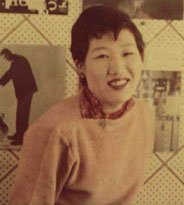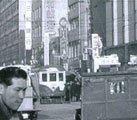Don De Armond

Don De Armond is a jazz-lover who came to Japan in the 1950s. He was a sailor stationed at Atsugi base, but in his off hours he explored Japan’s jazz scene, making friends with the owner of Japan’s most famous jazz coffee shop, Chigusa, in Yokohama. His photos are evocative views of Japan and jazz in Japan at that time. He answered questions by email and sent photos from his personal collection, all taken by him. It is with great pleasure that I offer his words and photos. All photos are from Don De Armond. I thank him for getting in touch with me. More photos are posted below!
When did you come to Japan and how?
I arrived in Tokyo on 5 February 1955 as a U.S Naval sailor assigned to Naval Air Station Atsugi for a two-year assignment.
Were you a jazz fan before you came to Japan?
My introduction to jazz began when a high school friend played a Louis Armstrong record for me.
What kind of music did you listen to at that time?
I started listening to Dixieland jazz on local radio. In 1953, I was fortunate to see and hear Louis Armstrong and his band including Jack Teagarden and Earl Hines at Club Hangover in San Francisco. As early as 1953, I was listening to the Stan Getz Auartet and Clifford Brown Quintet via local KJAZ radio.
How much time did you have to go out to clubs or jazz kissaten?
While stationed in Japan I had ample time week nights and weekends to spend time in music coffee shops in Yokohama and in Tokyo.
How did you find out about Chigusa?
A fellow Navy sailor, Dave Lacy, also stationed at Atsugi, knew of a jazz coffee house in Yokohama, and asked if I cared to join him there one hot August afternoon. As I had been a jazz music fan for a couple of years, I was eager to learn about American jazz in Japan. I wanted to know where I could experience some of the music, even if just on LPs.
Was it far from Atsugi?
Dave and I took the train from Sugami Otsuka into Yokohama, about a thirty minute ride. Chigusa was located quite near Sakarachigo Station, just a few minutes walk away. The neighborhood was a series of narrow streets, just wide enough for the tiny Japanese taxis, and lined with small restaurants, service shops, and jazz coffee house Chigusa. Japanese traditional music could be heard emanating from small cafes and bars in Yokohama. As we approached Chigusa, I could hear the familiar alto sax sounds of Lee Konitz. I knew then that I had found a second home, a friendly place where I would spend much of my time over the next two years. The owner, Mamoru Yoshida, and his younger sister, Takaka, were most friendly, welcoming, and pleased to meet another young American service man. Over the next two years, Chigusa became my second home. I met and made friends with many Japanese jazz fans, mostly men, as few women would be among the coffee drinkers
.What were your first impressions of the place?
My initial impressions, when I viewed jazz album covers on display, whenI heard modern jazz on the hi fi system, and with the aroma of fine coffee brewing,I felt like I had found a home. Chigusa consisted of one small room, with miniature wooden tables and chairs. There was a Japanese-style toilet room behind the shop. Toward the rear of the room stood a tall wooden counter. Atop the counter was a glass partition where Mr. Yoshida's prized turntable and dual speakers stood. His drip style coffee maker and an array of cakes and pastries were on display. In addition to delicious coffee, Chigusa offered sweet soft drinks in bottles, served at room temperature. Mamoru’s coffee house was always welcoming, with Mr. Yoshida busy preparing coffee and pastries, adjusting his speaker system, and changing records on his dual turntables.
What kind of music did he have?
On the two walls of Chigusa, Mamoru had installed original LP albums, with photographs of jazz musicians, set under glass. The album covers were all familiar to me: Lee Konitz, Zoot Sims, Shorty Rogers and his Giants, The Modern Jazz Quartet, Sonny Rollins, Charles Mingus, Dizzy Gillespie. I recall one album placed in a background of black crepe paper: Charlie Parker and Strings. Parker, the outstanding alto saxophonist of modern jazz, had recently passed away.
Was it easy to get a hold of jazz records then?
American jazz records were expensive for Mr. Yoshida to purchase. He analyzed each and every decision on which records to buy. I was able to purchase records on better prices at the Naval Base PX. At Mr. Yoshida's request I would on occasion buy albums that he wanted, yet were impossible to obtain in Yokohama. Japan was still experiencing black market pricing on goods and services since the War years.
What were the other customers like?
Chigusa customers were all Japanese men, in their late twenties and mid- thirties.A few spoke rudimentary English. As my knowledge of the language was limited, I relied on Japanese friends to recommend tearooms and coffee houses in Yokohama and in Tokyo.
What was Japanese people’s attitude towards jazz then?
From my experiences at Chigusa, I found the Japanese were most respectful of the music. It was common practice at Chigusa to listen in silence and drink coffee, with only occasional remarks made amongst themselves and with Mamoru. Chigusa was for jazz aficionados.
Where did you go to hear live jazz?
I recall hearing live jazz at Tea Room Shirobasha in Tokyo in 1956. It was located in central Tokyo a few blocks off Ginza Street. The musicians consisted of a Japanese rhythm section, with American horn players. I believe there were a number of American jazzmen who visited and performed in Tokyo in 1956/57. While I have several photos of visiting jazzmen, I do not recognize any of them. The Tea Room was spacious with the jazz group performing on a raised platform above the audience. Microphones were rudimentary. There was no dancing at Shirobasha. It was a comfortable cafe to relax and listen to the music.
How did your friendship with Chigusa’s owner grow?
Mamoru Yoshida and I became friends and our friendship lasted many years. His spoken English was quite good. Mamoru and his sister resided in rooms adjacent to the coffee house. When I returned to the States in 1957, Mamoru and I continued to correspond until 1963. During that time, we engaged in a record album order service; my locating and buying his precious albums and mailing them across the Pacific to Chigusa.
It’s quite a history, Chigusa and jazz!
Mamoru Yoshida and his Chigusa were in business from 1937 to 1941; closed by military direction during the war years; demolished by the allied forces bombing of Yokohama in May 1945; rebuilt and reopened in 1946; and continued under his management until his death in 1994. His sister, Takaka, continued operating Chigusa until December 2007, when it became too much of a burden for her. Quite an achievement for one man, Mamoru Yoshida, and his sister, Takaka, in bringing American jazz music to Yokohama and to Japan.
All photos are from Don De Armond, most circa 1955.
Mamoru Yoshida
Chigusa owner Mamoru Yoshida
Owner Mamoru Yoshida with Toshiko Akiyoshi
Owner Mamoru Yoshida with Toshiko Akiyoshi
Owner Mamoru Yoshida with Toshiko Akiyoshi































